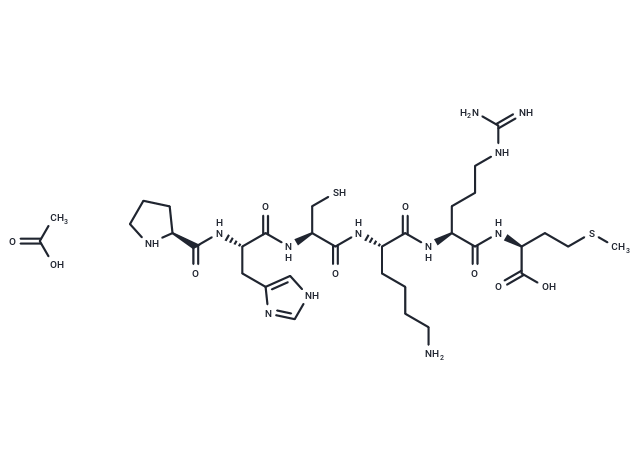Shopping Cart
- Remove All
 Your shopping cart is currently empty
Your shopping cart is currently empty

Antioxidant peptide A acetate is a short peptide, which contains alternative aromatic or sulfur-containing amino acid.

| Pack Size | Price | Availability | Quantity |
|---|---|---|---|
| 1 mg | $87 | In Stock | |
| 5 mg | $255 | In Stock | |
| 10 mg | $413 | In Stock | |
| 25 mg | $688 | In Stock | |
| 50 mg | $979 | In Stock | |
| 100 mg | $1,320 | In Stock | |
| 500 mg | $2,630 | In Stock |
| Description | Antioxidant peptide A acetate is a short peptide, which contains alternative aromatic or sulfur-containing amino acid. |
| In vitro | The effects of 10-100 μM of Antioxidant peptide A (Pep-A) concentrations are studied on the superoxide dismutase (SOD) enzyme activity. The enzyme activity decreases by 0.5 and 0.7-folds at 10 and 50 μM Antioxidant peptide A concentrations, respectively, and increases by 1.79-folds at 100 μM Antioxidant peptide A treatment, indicating that this concentration can be ideal for the treatment on Y79 a, RB cells. Furthermore, the Antioxidant peptide A can be involved in decreasing the ROS by increasing the antioxidant enzyme activity. A similar increase in the antioxidative enzyme levels in the presence of Hoki skin antioxidative peptide in hepatocarcinoma cells is attributed to the peptide’s role in maintaining the redox balance in the cellular environment. Cell viability analysis results show that the Antioxidant peptide A shows no toxicity to cancerous (Y79) cells and non-cancerous cells even after 48 h of treatment. The Y79 RB cell viability ranges between 115 and 157 % and 111-126 % after 24 and 48 h of exposures with Antioxidant peptide A, respectively. The cancer cell death from the treatment of 10-100 μM GNPs concentration is studied[1]. |
| Alias | Antioxidant peptide A acetate (159147-88-3 free base) |
| Molecular Weight | 831.02 |
| Formula | C33H58N12O9S2 |
| Smiles | CC(O)=O.O=C(N[C@@H](CC1=CNC=N1)C(N[C@@H](CS)C(N[C@@H](CCCCN)C(N[C@@H](CCCNC(N)=N)C(N[C@@H](CCSC)C(O)=O)=O)=O)=O)=O)[C@H]2NCCC2 |
| Relative Density. | no data available |
| Storage | keep away from moisture | Powder: -20°C for 3 years | In solvent: -80°C for 1 year | Shipping with blue ice. | ||||||||||||||||||||
| Solubility Information | DMSO: 10 mM | ||||||||||||||||||||
Solution Preparation Table | |||||||||||||||||||||
DMSO
| |||||||||||||||||||||

Copyright © 2015-2024 TargetMol Chemicals Inc. All Rights Reserved.